Hillenbrand Announces Fiscal Third Quarter 2021 Results
Date 2021-08-05 | Earning Reports
Hillenbrand Announces Fiscal Third Quarter 2021 Results
Fiscal Third Quarter 2021 Highlights:• Revenue of $695 million increased 14% year over year led by growth in Molding Technology Solutions; pro forma revenue increased 18%
• GAAP EPS of $0.53 increased 66% compared to the prior year; adjusted EPS of $0.85 increased 5% primarily driven by growth in Molding Technology Solutions
• Record total backlog of $1.77 billion increased 57% year over year, or 62% on a pro forma basis, led by large plastics projects in Advanced Process Solutions and injection molding equipment within Molding Technology Solutions; total backlog increased 16% sequentially
• Cash flow from operations of $184 million increased $109 million compared to the prior year driven by favorable timing of working capital; net leverage decreased to 1.4x, down 0.3x sequentially
• Completed ~$100 million of share repurchases through end of July 2021
• Fiscal Q4 2021 guidance: Adjusted EPS range of $0.82 to $0.92
BATESVILLE, Ind., August 4, 2021 --/PRNewswire/ --Hillenbrand, Inc. (NYSE: HI) reported results for the third quarter of fiscal 2021, which ended June 30, 2021.
“We had another strong quarter of performance with exceptional cash generation and record backlog due to continued momentum in our industrial businesses, while Batesville performed better than expected,” said Joe Raver, President and Chief Executive Officer of Hillenbrand. “I would like to thank our associates throughout the world for their continued dedication and execution in an environment that remains challenging due to COVID-19, rising inflation, and global supply chain disruptions. We remain focused on driving growth through strategic investments in our large platform businesses while capturing the full benefits of the Milacron integration. Our healthy balance sheet and solid backlog gives us confidence as we look to finish out a strong year for Hillenbrand.”
Third Quarter 2021 Results
Revenue of $695 million increased 14% compared to the prior year, primarily driven by growth within Molding
Technology Solutions and Advanced Process Solutions, partially offset by the divestitures of Red Valve and ABEL.
Total revenue increased 10% excluding the impact of foreign currency exchange. On a pro forma basis, which
excludes the divested Red Valve and ABEL businesses in Advanced Process Solutions, revenue increased 18% year over year, or 13% excluding the impact of foreign currency exchange.
Net income of $40 million, or $0.53 per share, increased $0.21, or 66%, largely due to volume growth in Molding Technology Solutions, productivity improvements, favorable pricing, and inventory step-up charges in the prior year that did not repeat. This growth was partially offset by inflation and unfavorable mix. Adjusted net income of $65 million resulted in adjusted EPS of $0.85, an increase of $0.04, or 5%. The adjusted effective tax rate for the quarter was 30.4%, an increase of 370 basis points from the prior year, primarily due to an increase in the recognition of deferred taxes on unremitted foreign earnings as well as an unfavorable impact of recent German tax legislation.
Adjusted EBITDA of $126 million increased 4% year over year. On a pro forma basis, adjusted EBITDA increased 7% primarily driven by higher volume. Adjusted EBITDA margin of 18.2% decreased 170 basis points compared to a year ago primarily due to cost inflation and unfavorable mix, which more than offset operating leverage from higher volume, productivity improvements, and favorable pricing.
Advanced Process Solutions (APS)
Revenue of $313 million increased 11% compared to the same period in the prior year. Revenue increased 5% excluding the impact of foreign currency exchange. On a pro forma basis, which excludes the divested Red Valve and ABEL businesses, revenue increased 18% year over year, or 11% excluding the impact of foreign currency, primarily driven by an increase in large plastics projects and favorable pricing.
Adjusted EBITDA of $61 million increased 6% year over year. On a pro forma basis, adjusted EBITDA increased 13% driven by higher volume, favorable pricing, and productivity improvements, partially offset by cost inflation and an increase in strategic investments. Adjusted EBITDA margin of 19.5% decreased 100 basis points on a pro forma basis as cost inflation and strategic investments more than offset productivity improvements, favorable pricing, and operating leverage from higher volume.
Record backlog of $1.4 billion increased 52% on a pro forma basis compared to the prior year, or 45% excluding the impact of foreign currency, primarily driven by an increase in order volume for large polyolefin systems. Sequentially, backlog increased 19% compared to the quarter ended March 31, 2021.
Molding Technology Solutions (MTS)
Revenue of $244 million increased 31% year over year driven by increases across all product lines. Excluding the impact of foreign currency, revenue increased 26%.
Adjusted EBITDA of $49 million increased 29%, largely driven by volume growth and productivity improvements, partially offset by unfavorable mix due to an increased proportion of injection molding equipment and cost inflation. Adjusted EBITDA margin of 20.2% decreased 30 basis points as the impact of unfavorable mix and cost inflation more than offset operating leverage from higher volume and productivity improvements.
Record backlog of $388 million increased 110% year over year driven by an increase in orders for injection molding, extrusion, and hot runner equipment. Sequentially, backlog increased 7% compared to the quarter ended March 31, 2021.
Batesville
Revenue of $138 million decreased 1% year over year due to lower burial casket sales resulting from an estimated decline in deaths associated with the COVID-19 pandemic. This decrease was partially offset by higher average selling price.
Adjusted EBITDA of $30 million decreased 18% year over year, and adjusted EBITDA margin of 21.6% was 440 basis points lower than the prior year primarily driven by commodity and non-commodity inflation and lower volume.
Balance Sheet, Cash Flow and Capital Allocation
Hillenbrand generated cash flow from operations of $184 million in the quarter, an increase of $109 million year over year, primarily driven by favorable timing of working capital and higher earnings. During the quarter, the Company repurchased approximately 993,000 shares for $43.4 million at an average share price of $43.73 and returned $16 million to shareholders in the form of quarterly dividends. Subsequent to the quarter, the Company purchased an additional 1,289,000 shares through the end of July for $56.6 million or an average share price of $43.88.
Net debt at the end of the quarter was $736 million, and the net debt to adjusted EBITDA ratio was 1.4x, a sequential decrease of 0.3x from March 31, 2021. As of quarter end, we had liquidity of approximately $1.4 billion, including $476 million in cash on hand and the remainder available under our revolving credit facility.
Fiscal Q4 2021 Outlook
Given continued uncertainties related to the COVID-19 pandemic, including pandemic duration, severity and resurgence in various parts of the world, vaccine availability and effectiveness, supply chain disruptions and other effects, the Company’s outlook assumes a continued gradual stabilization of the global economy and no significant increase in pandemic-related disruptions to the Company’s businesses:
• Total quarterly revenue is expected to be between $713 and $738 million, an increase of 6% to 9% year over year on a pro forma basis, which excludes Red Valve and ABEL◦ Advanced Process Solutions revenue is expected to be between $340 and $350 million, an increase of 9% to 12% on a pro forma basis, which excludes Red Valve and ABEL
◦ Molding Technology Solutions revenue is expected to be between $238 and $250 million, an increase of 10% to 15%◦ Batesville revenue is expected to be between $135 and $138 million, a decrease of 6% to 8%
• Adjusted EPS is expected to be in the range of $0.82 to $0.92
Hillenbrand’s financial statements on Form 10-Q are expected to be filed jointly with this release and will be made available on the company’s website (https://ir.hillenbrand.com).
In addition to the financial measures prepared in accordance with United States generally accepted accounting principles (GAAP), this earnings release also contains non-GAAP operating performance measures. These non-GAAP measures are referred to as “adjusted” measures and exclude the following items:
• business acquisition, disposition, and integration costs;
• restructuring and restructuring related charges;
• impairment charges;
• inventory step-up charges;
• intangible asset amortization;
• certain debt financing activities;
• gains and losses on divestitures;
• COVID-19 pandemic-related costs;
• the related income tax impact for all of these items; and
• the interaction of tax benefits and expenses related to the foreign income inclusion tax provisions and certain tax carryforward attributes associated with the acquisition of Milacron and divestitures, including the tax provisions related to the imposition of tax on Global Intangible Low-Taxed Income (GILTI) earned by certain foreign subsidiaries, the Foreign Derived Intangible Income Deduction (FDII), and the Base Erosion and Anti-Abuse Tax (BEAT) and their impact on loss carryforwards and foreign tax credits; and the revaluation of deferred tax balances as a result of functional currency fluctuations.
In consideration of the Milacron acquisition, beginning with the quarter ended June 30, 2020, the Company has reported adjusted EPS results that exclude after-tax acquisition-related intangible amortization, in addition to backlog amortization excluded in previous periods. Prior year periods have been restated to conform to the presentation in the current year periods. The Company believes reporting adjusted EPS in this manner better reflects its core operating results and offers greater consistency and transparency.
Refer to the Reconciliation of Non-GAAP Measures for further information on these adjustments. Non-GAAP information is provided as a supplement to, not as a substitute for, or as superior to, measures of financial performance prepared in accordance with GAAP.
Hillenbrand uses this non-GAAP information internally to make operating decisions and believes it is helpful to investors because it allows more meaningful period-to-period comparisons of ongoing operating results. The information can also be used to perform trend analysis and to better identify operating trends that may otherwise be masked or distorted by items such as the above excluded items. Hillenbrand believes this information provides a higher degree of transparency.
One important non-GAAP measure Hillenbrand uses is adjusted earnings before interest, income tax, depreciation, and amortization (“adjusted EBITDA”). A part of our strategy is to pursue acquisitions that strengthen or establish leadership positions in key markets. Given that strategy, it is a natural consequence to incur related expenses, such as amortization from acquired intangible assets and additional interest expense from debt-funded acquisitions. Accordingly, we use adjusted EBITDA, among other measures, to monitor our business performance. We also use “adjusted net income” and “adjusted diluted earnings per share (EPS),” which are defined as net income and earnings per share, respectively, each excluding items described in connection with adjusted EBITDA. Adjusted EBITDA, adjusted net income, and adjusted diluted EPS are not recognized terms under GAAP and therefore do not purport to be alternatives to net (loss) income or to diluted EPS, as applicable. Further, Hillenbrand’s measures of adjusted EBITDA, adjusted net income, or adjusted diluted EPS may not be comparable to similarly titled measures of other companies.
Another important non-GAAP operational measure used is backlog. Backlog is not a term recognized under GAAP; however, it is a common measurement used in industries with extended lead times for order fulfillment (long-term contracts), like those in which the Advanced Process Solutions and Molding Technology Solutions reportable operating segments compete. Backlog represents the amount of net revenue that we expect to realize on contracts awarded to Advanced Process Solutions and Molding Technology Solutions reportable operating segments. For purposes of calculating backlog, 100% of estimated net revenue attributable to consolidated subsidiaries is included. Backlog includes expected net revenue from large systems and equipment, as well as aftermarket parts, components, and service. The length of time that projects remain in backlog can span from days for aftermarket parts or service to approximately 18 to 24 months for larger system sales within the Advanced Process Solutions reportable operating segment. The majority of the backlog within the Molding Technology Solutions reportable operating segment is expected to be fulfilled within the next twelve months. Backlog includes expected revenue from the remaining portion of firm orders not yet completed, as well as net revenue from change orders to the extent that they are reasonably expected to be realized. Hillenbrand includes in backlog the full contract award, including awards subject to further customer approvals, which we expect to result in revenue in future periods. In accordance with industry practice, Hillenbrand’s contracts may include provisions for cancellation, termination, or suspension at the discretion of the customer.
Hillenbrand expects that future revenue associated with Advanced Process Solutions and Molding Technology Solutions will be influenced by order backlog because of the lead time involved in fulfilling engineered-to-order equipment for customers. Although backlog can be an indicator of future net revenue, it does not include projects and parts orders that are booked and shipped within the same quarter. The timing of order placement, size, extent of customization, and customer delivery dates can create fluctuations in backlog and net revenue. Net revenue attributable to backlog may also be affected by foreign exchange fluctuations for orders denominated in currencies other than U.S. dollars.
Pro forma revenue and pro forma adjusted EBITDA are defined respectively as net revenue and adjusted EBITDA excluding net revenue and adjusted EBITDA directly attributable to Red Valve which was divested on December 31, 2020 and ABEL which was divested on March 10, 2021, excluding net revenue and adjusted EBITDA directly attributable to the Cimcool business which was divested on March 30, 2020, and including net revenue and adjusted EBITDA attributable to Milacron as if the acquisition had occurred on October 1, 2019. Hillenbrand uses pro forma measures to assess performance of its reportable segments and the Company in total without the impact of recent acquisitions and divestitures.
Hillenbrand calculates the foreign currency impact on net revenue in order to better measure the comparability of results between periods. We calculate the foreign currency impact by translating current year results at prior year foreign exchange rates. This information is provided because exchange rates can distort the underlying change in sales, either positively or negatively.
See below for a reconciliation from GAAP operating performance measures to the most directly comparable non-GAAP (adjusted) performance measures. Given that there is no GAAP financial measure comparable to backlog, a quantitative reconciliation is not provided. In addition, forward-looking adjusted earnings per share for the fourth quarter of fiscal 2021 excludes potential charges or gains that may be recorded during the fiscal year, including among other things, items described above in connection with other “adjusted” measures. Hillenbrand thus also does not attempt to provide reconciliations of forward-looking non-GAAP earnings guidance to the comparable GAAP measure, as permitted by Item 10(e)(1)(i)(B) of Regulation S-K, because the impact and timing of these potential charges or gains is inherently uncertain and difficult to predict and is unavailable without unreasonable efforts. In addition, the Company believes such reconciliations would imply a degree of precision and certainty that could be confusing to investors. Such items could have a substantial impact on GAAP measures of Hillenbrand’s financial performance.

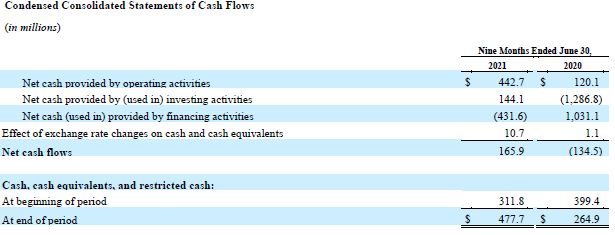
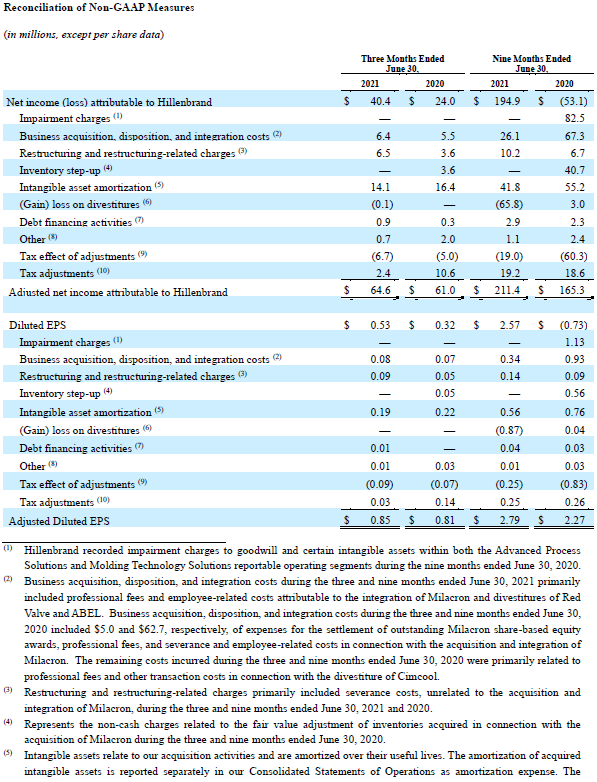
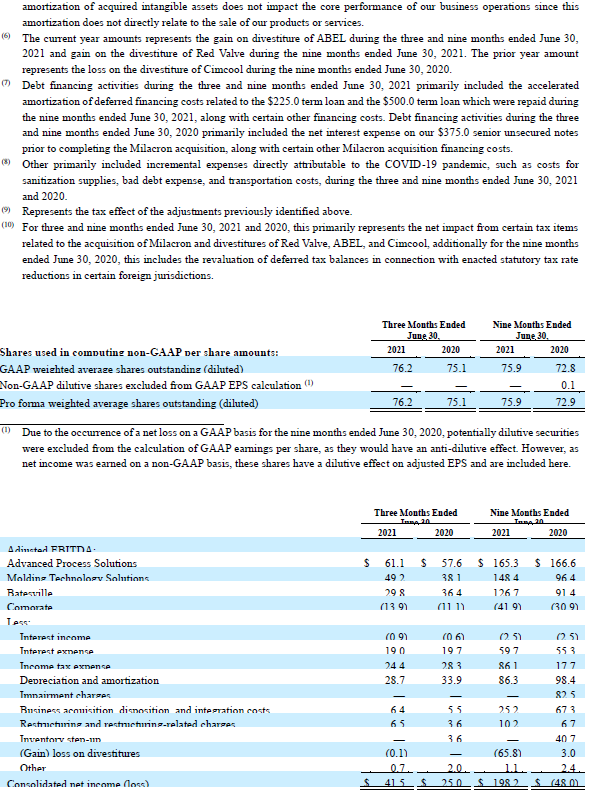
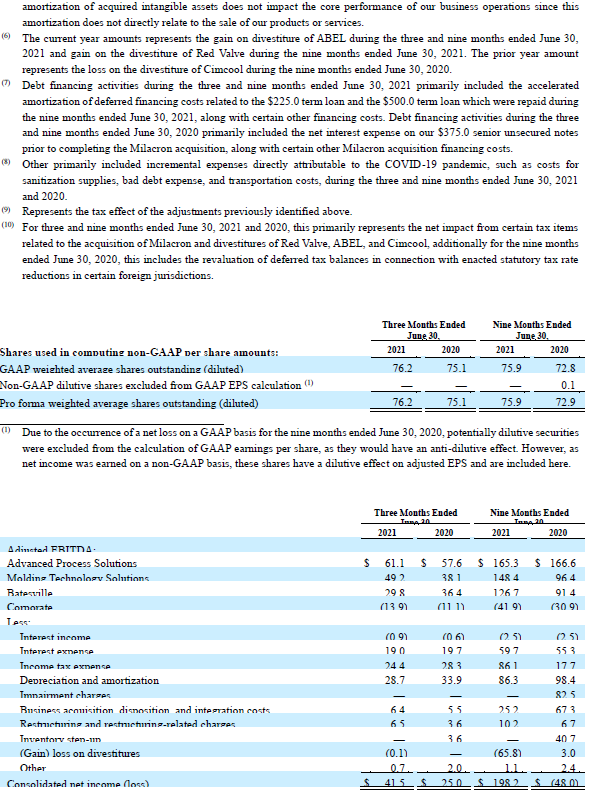
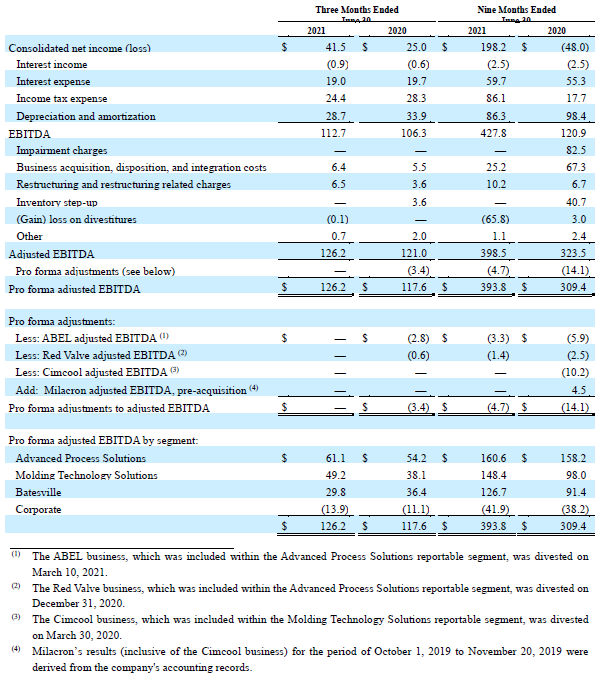


Forward-Looking Statements
Throughout this release, we make a number of “forward-looking statements” that are within the meaning of Section 27A of the Securities Act of 1933, as amended (the “Securities Act”), Section 21E of the Securities Exchange Act of 1934, as amended, and the Private Securities Litigation Reform Act of 1995, and that are intended to be covered by the safe harbor provided under these sections. As the words imply, these are statements about future sales, earnings, cash flow, results of operations, uses of cash, financings, share repurchases, ability to meet deleveraging goals, and other measures of financial performance or potential future plans or events, strategies, objectives, beliefs, prospects, assumptions, expectations, and projected costs or savings or transactions of the Company that might or might not happen in the future, as contrasted with historical information. Forward- looking statements are based on assumptions that we believe are reasonable, but by their very nature they are subject to a wide range of risks. If our assumptions prove inaccurate or unknown risks and uncertainties materialize, actual results could vary materially from Hillenbrand’s (the “Company”) expectations and projections.
Words that could indicate that we are making forward-looking statements include the following:
intend believe plan expect may goal would project
become pursue estimate will forecast continue could anticipate
target encourage promise improve progress potential should impact
This is not an exhaustive list, but is intended to give you an idea of how we try to identify forward-looking statements. The absence of any of these words, however, does not mean that the statement is not forward-looking.
Here is the key point: Forward-looking statements are not guarantees of future performance, and our actual results could differ materially from those set forth in any forward-looking statements. Any number of factors, many of which are beyond our control, could cause our performance to differ significantly from what is described in the forward-looking statements. These factors include, but are not limited to: the impact of contagious diseases such as the COVID-19 pandemic and the escalation thereof due to variant strains of the virus and the societal, governmental, and individual responses thereto, including supply chain disruption, loss of contracts and/or customers, erosion of some customers' credit quality, downgrades of the Company's credit quality, closure or temporary interruption of the Company's or suppliers' manufacturing facilities, travel, shipping and logistical disruptions, loss of human capital or personnel, and general economic calamities; risks that the integration of Milacron disrupts current operations or poses potential difficulties in employee retention or otherwise affects financial or operating results; the ability to recognize the benefits of the acquisition of Milacron or any other acquisition or disposition, including potential synergies and cost savings or the failure of the Company or any acquired company to achieve its plans and objectives generally; impairment charges to goodwill and other identifiable intangible assets; the risk of business disruptions associated with information technology, cyber-attacks, or catastrophic losses affecting infrastructure; competition in the industries in which we operate, including on price or from nontraditional sources in the death care industry; impacts of decreases in demand or changes in technological advances, laws, or regulation on the revenues that we derive from the plastics industry; our reliance upon employees, agents, and business partners to comply with laws in many countries and jurisdictions; the impact of the significant amount of indebtedness of the Company and its ability to meet its de-leveraging goals; the ability of the Company to comply with financial or other covenants in its debt agreements; global market and economic conditions, including those related to the financial markets; our level of international sales and operations; cyclical demand for industrial capital goods; continued fluctuations in mortality rates and increased cremations; the dependence of our business units on relationships with several large customers and providers; the impact to the Company's effective tax rate of changes in the mix of earnings or tax laws and certain other tax-related matters; involvement in claims, lawsuits and governmental proceedings related to operations; uncertainty in the United States political environment or global trade policy; adverse foreign currency fluctuations; increased costs or unavailability of raw materials or certain outsourced services; labor disruptions; increasing competition for highly skilled and talented workers; and the effect of certain provisions of the Company's governing documents and Indiana law that could decrease the trading price of the Company's common stock. Shareholders, potential investors, and other readers are urged to consider these risks and uncertainties in evaluating forward-looking statements and are cautioned not to place undue reliance on the forward-looking statements. For a more in-depth discussion of these and other factors that could cause actual results to differ from those contained in forward-looking statements, see the discussions under the heading "Risk Factors" in Part I, Item 1A of Hillenbrand's Form 10-K for the year ended September 30, 2020, filed with the Securities and Exchange Commission
("SEC") on November 12, 2020, and in Part II, Item 1A of Hillenbrand’s Form 10-Q for the quarter ended June 30, 2021, filed with the SEC on August 4, 2021. The forward-looking information in this release speaks only as of the date hereof, and we assume no obligation to update or revise any forward-looking information.